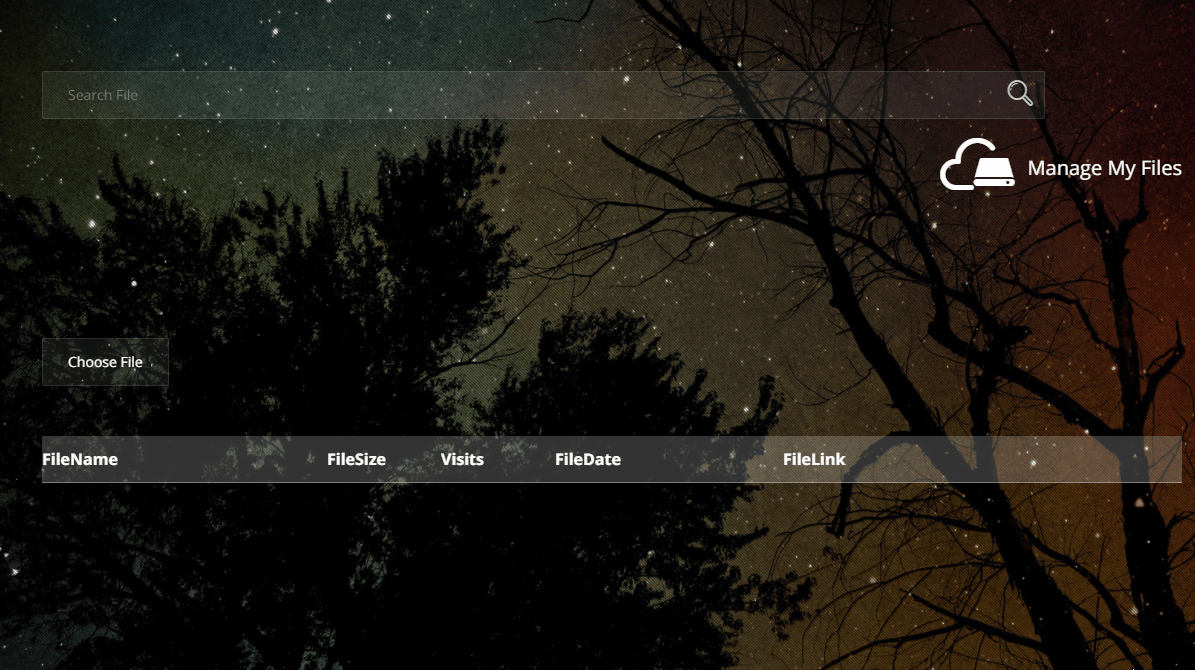Django實現文件分享系統的完整代碼
一、效果展示
文件上傳和展示:


文件搜索:

文件下載:

刪除文件:

二、關鍵代碼
#urls.py
from django.urls import path,re_path
from .views import HomeView,DisplayView,MyView,SearchView
from . import views
app_name = 'share'
urlpatterns = [
path('', HomeView.as_view(), name='home'),
# 當用戶發起主頁的GET請求時
# 會調用 HomeView的父類的get方法處理
# 怎麼調用呢,這裡需要用到HomeView的父類的as_view方法
# 此方法會調用dispatch方法, 由後者根據請求類型選擇響應的處理函數
path('s/<code>', DisplayView.as_view(), name='display'), #展示上傳成功的文件
path('my/', MyView.as_view(), name='my'), #管理文件
path('search/', SearchView.as_view(), name='search'), #搜索文件
re_path(r'^download/(?P<id>\d*$)', views.Download, name='download'), #下載文件
re_path(r'^delete/(?P<id>\d*$)', views.DeleteFile, name='delete'), #刪除文件
]
#views.py
from django.shortcuts import render
from django.views.generic import TemplateView,ListView
import random
import string
import json
from django.http import HttpResponse,HttpResponsePermanentRedirect,StreamingHttpResponse,HttpResponseRedirect
from .models import Upload
import os
# 創建視圖類需要基礎視圖基類
# 例如 TemplateView 就是用於展示頁面的模板視圖基類
# 該類僅提供get方法,用於處理GET請求
# 當然也可以自定義其他方法,例如post
# 展示主頁的話,隻需要提供模板文件的名字即可
# 當客戶端發起get請求時,由父類的get方法處理請求
# 該屬性用於提供模板文件,在父類的方法中被調用
class HomeView(TemplateView):
'''用來展示主頁的視圖類
'''
template_name = "base.html"
def post(self, request):
if request.FILES: #如果表單中有文件
file = request.FILES.get('file')
code = ''.join(random.sample(string.digits, 8)) #設置文件的唯一標識code,並且用作文件改名
name = file.name
size = int(file.size)
path = 'filesystem/static/file/' + code + name #設置文件保存的路徑,並且更改文件名(防止重名文件)
with open(path, 'wb') as f:
f.write(file.read()) #保存文件
upload = Upload(
path = path,
name = name,
filesize = size,
code = code,
pcip = str(request.META['REMOTE_ADDR'])
)
upload.save() #向數據庫插入數據
return HttpResponsePermanentRedirect("/share/s/"+code) #重定向到DisplayView
class DisplayView(ListView):
'''展示文件的視圖類
'''
def get(self, request, code):
uploads = Upload.objects.filter(code=code) #顯示出指定文件
if uploads:
for upload in uploads:
upload.dowmloadcount += 1 #記錄訪問次數
upload.save()
return render(request, 'content.html', {'content':uploads, 'host':request.get_host()})
class MyView(ListView):
'''
用戶管理視圖類,就是用戶管理文件的那個頁面的視圖類
'''
def get(self, request):
#ip = request.META['REMOTE_ADDR']
#uploads = Upload.objects.filter(pcip=ip)
uploads = Upload.objects.all() #查詢所有文件
for upload in uploads:
upload.dowmloadcount += 1
upload.save()
return render(request, 'content.html', {'content':uploads}) #將所有文件信息渲染展示
class SearchView(ListView):
'''搜索功能的視圖類
'''
def get(self, request):
code = request.GET.get('kw') # 獲取關鍵詞
u = Upload.objects.filter(name__icontains=str(code)) # 模糊搜索
# select * from share_upload where name like '%code%';
data = {}
if u:
# 將符合條件的數據放到data中
for i in range(len(u)): # 循環輸出查詢的結果
u[i].dowmloadcount += 1
u[i].save()
data[i]={}
data[i]['download'] = u[i].dowmloadcount
data[i]['filename'] = u[i].name
data[i]['id'] = u[i].id
data[i]['ip'] = str(u[i].pcip)
data[i]['size'] = u[i].filesize
data[i]['time'] = str(u[i].datetime.strftime('%Y-%m-%d %H:%M'))
return HttpResponse(json.dumps(data), content_type="application/json")
def Download(request, id):
"""
下載壓縮文件
:param request:
:param id: 數據庫id
:return:
"""
data = Upload.objects.all()
file_name = "" # 文件名
for i in data:
if i.code == id: # 判斷id一致時
file_name = i.name # 覆蓋變量
base_dir = os.path.dirname(os.path.dirname(os.path.abspath(__file__))) # 項目根目錄
file_path = os.path.join(base_dir, 'filesystem', 'static', 'file', file_name) # 下載文件的絕對路徑
if not os.path.isfile(file_path): # 判斷下載文件是否存在
return HttpResponse("Sorry but Not Found the File")
def file_iterator(file_path, chunk_size=512):
"""
文件生成器,防止文件過大,導致內存溢出
:param file_path: 文件絕對路徑
:param chunk_size: 塊大小
:return: 生成器
"""
with open(file_path, mode='rb') as f:
while True:
c = f.read(chunk_size)
if c:
yield c
else:
break
try:
# 設置響應頭
# StreamingHttpResponse將文件內容進行流式傳輸,數據量大可以用這個方法
response = StreamingHttpResponse(file_iterator(file_path))
# 以流的形式下載文件,這樣可以實現任意格式的文件下載
response['Content-Type'] = 'application/octet-stream'
# Content-Disposition就是當用戶想把請求所得的內容存為一個文件的時候提供一個默認的文件名
response['Content-Disposition'] = 'attachment;filename="{}"'.format(file_name)
except:
return HttpResponse("Sorry but Not Found the File")
return response
def DeleteFile(request, id):
'''刪除指定文件'''
data = Upload.objects.all()
file_name = "" # 文件名
for i in data:
if i.code == id: # 判斷id一致時
file_name = i.code + i.name # 覆蓋變量
base_dir = os.path.dirname(os.path.dirname(os.path.abspath(__file__))) # 項目根目錄
file_path = os.path.join(base_dir, 'filesystem', 'static', 'file', file_name) # 下載文件的絕對路徑
if os.path.exists(file_path):
os.remove(file_path)
file = Upload.objects.get(code=id)
file.delete()
return HttpResponseRedirect('/share/my/')
'''
except Exception as e:
return http.HttpResponseForbidden('文件不存在,下載失敗!')
'''
到此這篇關於Django實現文件分享系統的完整代碼的文章就介紹到這瞭,更多相關Django文件分享系統內容請搜索WalkonNet以前的文章或繼續瀏覽下面的相關文章希望大傢以後多多支持WalkonNet!
推薦閱讀:
- Django上傳xlsx文件直接轉化為DataFrame或直接保存的方法
- python Django實現增刪改查實戰代碼
- Python Django搭建文件下載服務器的實現
- Django URL和View的關系說明
- django實現圖片上傳數據庫並顯示